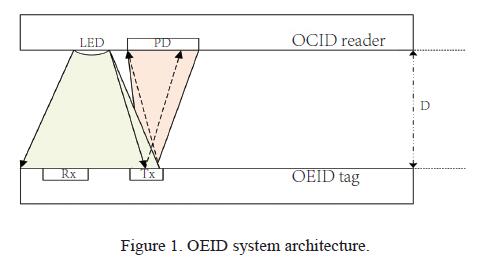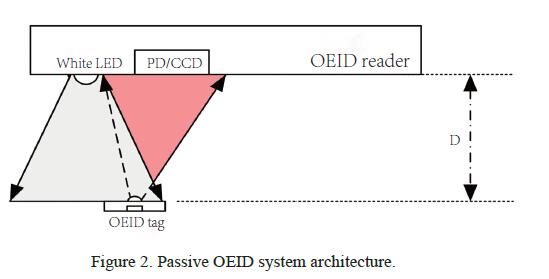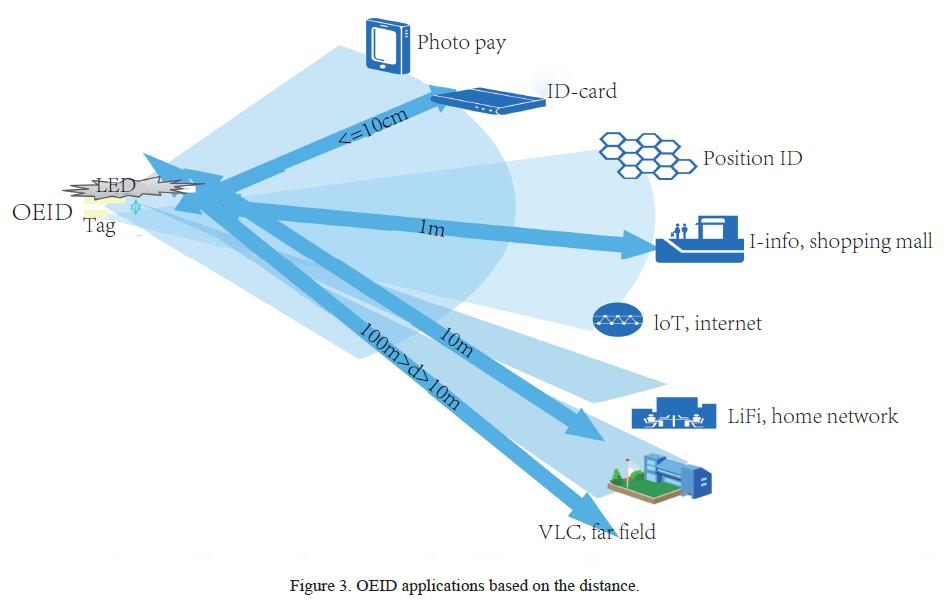OEID: A New Tag Technology in Optical Wireless Communications

Introduction
Modern society is an information society, and social media like facebook and twitter focus on the connection between people based on the internet. Smart home and appliances are emerging, and the internet of things (IoT) will connect everything on the internet in the future. Tags are important for IoT and most of them are non-contact type, such as barcode and radio-frequency identification (RFID). Barcode tags cannot be edited, but RFID tags can. Therefore, RFID has been widely applied in transportation cards, bank cards and hotel room keys. RFID is based on mature wireless RF communication technologies and can work from low frequency (LF) to ultra high frequency (UHF).
With regard to RFID transmission principles, the magnetic induction coupling can be applied to the near field, while the electromagnetic transmission applied to the far field. However, there are still problems for RFID working in the electromagnetic and metal environments.
The increasing broadband demands have pushed the use of communication frequencies from kHz to GHz, and then to THz, that is, from RF to optical waves. Optical wave including infrared has been used for communications, and visible lights for illumination have also been used for communications. Visible light communication (VLC) based on light emitting diodes (LEDs) has been considered as a promising technology for future wireless communication. Illumination LEDs captured almost 45% of the lighting market in 2015 and is expected to gain more market share in the future. This is the fundamental base for VLC development. Optoelectronic identification (OEID) based on VLC has therefore attracted much attention.
OEID belongs to a non-contact ID system working at the same optical wireless communication range as VLC. The OEID architecture is shown in Fig. 1.

According to the tag power supply status, OEID can be classified into active OEID, semi-active OEID, and passive OEID.
An active OEID system has an active tag with its own power supply. In this system, there are little difference between the reader and tag. Therefore, the roles of the reader and tag can be exchanged.
An OEID tag can be an external part that is inserted or integrated into a marked device. One of the near field active OEID applications is mobile payment. In this scenario, a POS machine and a cell phone serve as the reader and tag. In the future, any electronic devices may be labeled; if they are marked by OEID, both mobile and fixed devices such as cell phones and LED lamps can be used as OEID reader to collect ID and location information.
If the definition of the active OEID is expanded, the VLC in a home network such as light fidelity (Li-Fi) can also be an example of active OEID system. LED lamps in a LiFi system can communicate with any electronic device inside the room and the communication mode can be point to point (P2P) or point to multiple point (P2MP).
In a semi-active OEID system, an OEID tag brings its own battery and is independent of a marked object. The OEID tag can be attached on anything. However, its limited battery life affects the application of the semi-active OEID system. Therefore, the battery must be exchangeable or rechargeable to extend its lifetime. The semi-active OEID is suitable for applications with a time limit, such as tickets, visitor cards and hotel room cards.
A passive OEID system has a passive tag that gets energy from the reader or outside light (Fig. 2).

The passive OEID system is a bi-directional VLC system. The OEID reader has a PD to receive tag data, and the white LED is used as a transmitter that sends instructions or transfers energy to the OEID tag. The tag converts light into an electronic source for running its chip and driving its LED. The distance D between the reader and tag depends on the tag size. If the tag size is smaller than 10 mm × 10 mm, D should be below 20 mm. When D increases, the OEID tag size need to be increased too. Most passive OEID applications are near field.
A passive OEID tag consists of the solar cell, LED, and OEID chip. PVD is used as the solar cell that converts continuous wave light into direct electronic voltage. It can also be used as a receiver to detect ves as both the energy provider and the receiver in the OEID tag. Silica is typical material for solar cells, and only white LED solar cells with high energy conversion rate and matched spectrum can be chosen. The size of an OEID tag is determined by the size of a solar cell. LED is used as the tag transmitter that consumes most power of the OEID tag. Because the OEID tag is passive, LED operating at very low power such as below 1 mW can be chosen. There are at least five units in an OEID chip. The electronic source management unit manages the offering of electronic sources to the whole chip and transfers downstream data to the control and management (CM) unit. The CM unit deals with downstream data and controls LED for reply. The LED driver unit follows the order from the CM unit to drive the LED by sending upstream data to the reader. The ID memory unit stores ID data of the tag. The OEID chip must be designed with low power consumption (a few mW).

Both OEID and RFID can store information. OEID is more energy efficient than RFID because it transfers information via light. OEID also outperforms RFID in electromagnetic and metal environments. OEID has wide applications that can be classified based on the distance (Fig.3).

OEID can be widely applied in public and business areas such as mobile payment, ID cards, position ID, advertising, anti-counterfeiting label, and information acquisition.
Apple Pay is a well-known mobile payment based on the near field communication (NFC)—the 13.56 MHz RFID technology. This application requires special NFC phone and App, special NFC POS machine and related software. However, there are still security problems to be overcome. OEID can also be used for mobile payment called Photon Pay. The flashlight and camera of a cell phone can be used as an OEID tag/reader receiver or transmitter. Photon Pay does not require a special phone. Any cell phone can be used as an OEID phone after installing the OEID App software. The POS machine becomes an OEID POS after an OEID head is inserted. The OEID phone and POS can work together to implement photon payment.
Passive OEID tags can be used in ID cards such as keys, band-cards, transportation cards, work cards and hotel room cards, and the corresponding OEID reader can be integrated into a POS machine, a lock or a bank machine. The verification process can be identified between the OEID reader and its tag card.
Accurate goods location is quite useful for storage and retail stores. OEID outperforms RFID in accurate locating tags within mm range. Each OEID tag on the goods has a LED, and any person or camera can easily locate this tag when the LED flickers. OEID can improve localization accuracy up to the mm range.
There is a lot of advertising information in shopping malls or business centers to attract customers. An information centre is often found at a place marked with a big “I” where someone can answer customer questions. If an active OEID tag is added to the “I” lamp, any customer can use its own cell phone to receive the advertising information he wants.
An OEID tag cannot be simply copied as a barcode or a QR code, and is hard to forge. Most OEID tags can be read by cell phones but not be edited without a special OEID reader. Therefore, anti-counterfeiting labeling is a good choice for valuable goods.
When an OEID tag is integrated with some sensors, the OEID system can offer electronic source to sensors and also automatically save sensor data. The OEID system is used for monitoring and recording at special places. The recorded data can be even remotely acquired by fixed or mobile OEID readers.
OEID has promising commercial prospects. An OEID tag can be used for resource management in the communications industry; and used for material management in the electric power industry. As many military supplies such as firearms and ammunition have ferromagnetic shells and can be detonated by electromagnetic field, OEID rather than RFID is used. OEID is also applied to the medical industry, because medical devices are often sensitive to the electromagnetic field and the radiation to human body should be avoided at certain cases.
In the IoT, wireless passive OEID will play a similar role as RFID and be widely applied. If connected to a sensor at the monitoring site, OEID can also save data that will be collected and transferred to the central office by the reader.
Both OEID and RFID are wireless tag technologies. RFID is a field-proven technology based on radio frequency communication and has been widely applied. OEID is an emerging technology based on optical wireless communication especially VLC and is also called RFID in the optical domain.
A passive OEID tag consists of the solar cell, LED and OEID chip. With the development of CMOS and silica technologies, it can be expected all components of the OEID tag will be integrated into one chip. This will significantly reduce OEID costs and extend its applications. The active OEID application ranges from near field to far field. A typical near field application is photon pay that can compete against Apple pay or Android pay based on the NFC technology. Another popular home network application is LiFi that can compete against WiFi.